Introduction
Scientific names
Common names
Foreign names
Distinguishing features
Size
Weight
Geographical distribution
Life history
Methods of capture
Chemical composition
Physical composition and yields
Other useful facts and figures
This note summarizes some general information about the cod and is intended to serve as useful background material for those in the industry who want to know a little more about the most important commercial species in Britain. The information includes scientific names, common names and foreign names for cod. The distinguishing features of the fish are described, and some notes are included on the life history of cod. Information is also given on methods of capture, quantities landed and minimum legal size, together with notes on the physical and chemical composition of cod and the shelf life of the principal products. The tables and graphs should be used only as guides; individual cod, like other fish, can vary considerably from the average.
The most generally accepted scientific name for the cod is Gadus morhua. The name Gadus callarias is also frequently met with but this is less correct. Moreover the word morhua is sometimes spelt morhua but the first spelling is now the accepted one.
Although the name ‘cod’ is used in other parts of the world to describe fishes unrelated to Gadus morhua, there is no problem of identification in Britain; cod means only this one species and there are no other conflicting common names in general use to confuse the issue.
The name Atlantic cod is sometimes used, particularly in North America, in order to avoid confusion with a quite different species, the Pacific cod, Gadus macrocephalus. Small cod are usually known as codling, and fishes intermediate in size between cod and codling are sometimes called sprags; the sizes to which these names refer are given later in this note. The name poor cod is used to describe a smaller and much less important relative of the cod, Gadus minutus.
Having said that the cod is known as such everywhere in Britain, it may be of interest to list some of the local names that have been applied to this fish from time to time; most of them are now no longer in use, even in remote fishing communities. Among the names are blockie, dolefish, droud, duncan, heaver, horgan, keelin’, kleg, kylling, poullach, ruggie and stuckie. Cod bearing the colouring and markings peculiar to those caught on rocky ground have been variously known as redware cod, rock cod, warey codlin’ and warey keelin’, while cod caught in poor condition have been named poor John, shingler, slinger, slink and sousler cod. Cod of small size, that is codling, have been known as coddie, josser, purr, Scots Willie, tamling and tommy cod. The recommended retail trade names for the species are cod or codling, according to size.
|
Danish: |
torsk |
Norwegian: |
torsk; skrei |
|
Dutch: |
kabeljauw |
Polish: |
dorsz; watlusz |
|
Finnish: |
turska |
Portuguese: |
bacalhau; bacalhao |
|
French: |
cabillaud; morue |
Russian: |
treska |
|
German: |
Kabeljau; Dorsch |
Spanish: |
bacalao; baccala |
|
Greek: |
gados bacaliaros |
Swedish: |
torsk |
|
Hebrew: |
shibbut zefoni |
Turkish: |
morina |
|
Icelandic: |
thorskur; Islandssléttbakur |
Yugoslavian: |
bakalar-ugotica |
|
Italian: |
merluzzo bianco |
|
|
The body of the cod is roughly cylindrical, 4-6 times as long as it is deep, and tapering towards head and tail. The length of the head, from the snout to the rear of the gill cover, is about a quarter of the total length, but very large cod sometimes have disproportionately large heads. The lower jaw, which is shorter than the upper one, has a fairly long fleshy filament or barbel, beneath it.
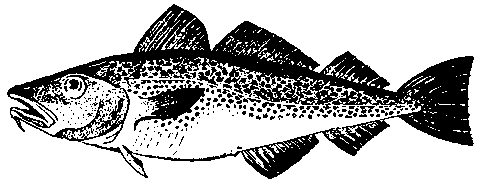
The upper part of the body is usually olive green with numerous darker blotches giving a marbled effect, but the principal colour may vary towards grey, brown, red or yellow depending upon the nature of the sea bottom; the cod can change its colour and pattern to suit its surroundings. The lower part of the body is white. The lateral line is white and curves slightly over the shoulder fins. The skin is covered with small scales, but is smooth to the touch. There are three soft-rayed fins along the back, the first of which is roughly triangular in shape, and there are two single fins on the underside between vent and tail. There is a pair of fins at the throat, called the pelvic fins, and a pair of shoulder, or pectoral, fins a little further back and higher up, just behind the gill covers. The rear edge of the tail fin is almost straight.
There is on record a cod measuring over 6 feet in length and weighing 211 lb, but in present-day landings cod 5 feet long are rare and cod over 4 feet are unusual. More than 90 per cent of the cod landed in Britain are less than 3 feet long.
Cod are sometimes sorted into four size ranges for the purposes of sale, namely cod, sprag, codling and small codling, but more usually into two sizes only, cod and codling. The following are the generally accepted lengths for each size range, but the dividing line between cod and codling is changed a little from time to time at individual ports to match the market demand to the size offish available:
|
four sizes: |
|
|
|
two sizes: |
|
|
|
length |
|
length |
||
|
|
cm |
inches |
|
cm |
inches |
|
cod |
76 & over |
30 & over |
}cod |
63 & over |
25 & over |
|
sprag |
63-75 |
25-29 |
}cod |
|
|
|
codling |
54-62 |
21-24 |
}codling |
30-62 |
12-24 |
|
small codling |
30-53 |
12-20 |
}codling |
|
|
The weight of a cod in relation to its length is shown in the following graph. The weight of a cod of given length will vary a little from ground to ground, and from season to season, but nevertheless the curves are a sufficiently good guide for most practical purposes. The weights given are for gutted fish.
Approximate length-weight ratio for cod
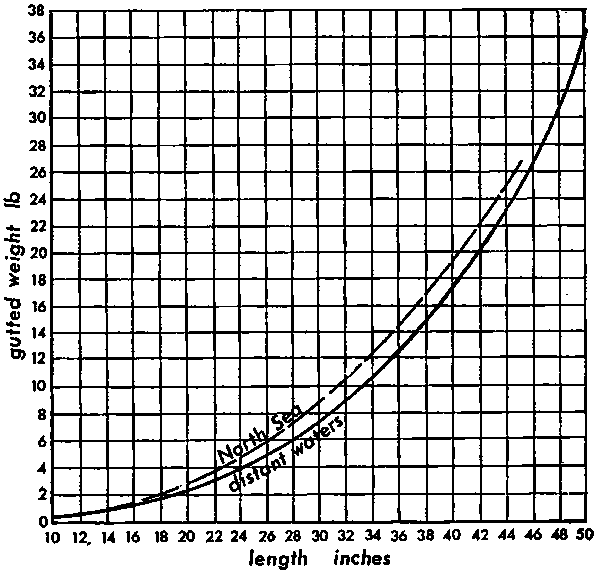
The variation of length and weight of cod with age is discussed later under life history.
The cod is found all over the north Atlantic and Arctic Oceans in depths of water down to about 250 fathoms. The principal stocks occur between 50°N and 75°N in the north-east Atlantic and between 40°N and 70°N in the north-west Atlantic. The most important fishing grounds in the northeast are the North Sea, the northern coast of Norway, Bear Island, and the Barents Sea to Spitzbergen in the north and Novaya Zemlya in the east. Iceland and the Faroe Islands are important fishing grounds and, in the north-west Atlantic, cod are abundant off Newfoundland, Labrador and west Greenland up to the Davis and Hudson Straits.
Although there are occasional irregular movements of cod from one oceanic area to another, generally speaking the stocks of cod in any one area are not much affected by these migrations.
The cod is typically a bottom-living, or demersal, fish and is usually found in the bottom few fathoms in depths from 10-250 fathoms, but at times when it is in pursuit of food it can be found anywhere between the surface and the sea bottom. It is found mostly on rocky, pebbly, sandy or gravelly bottoms, but is seldom found on muddy bottoms.
The cod prefers the open sea to estuaries, and is found in water varying in temperature from 30-50°F, but it is most plentiful in water from 32-40 °F.
The adult cod is carnivorous and when hungry will eat almost any marine animal including other cod, but it feeds mainly on the smaller fatty fishes such as herring, capelin and sand eels, and on shrimp and squid. The cod depends largely on its sense of smell when seeking food, since it cannot see more than a few feet. Cod on certain grounds, for example Spitzbergen, occasionally feed on large numbers of a small floating mollusc related to the snails; when captured these have a strong smell of seaweed or iodine and are often called stinker or blackberry cod. The term stinker is also applied, rather confusingly, to cod that have been stowed in direct contact with a smooth surface such as a pound board, resulting in very rapid spoilage and the production of foul smells.
The movements of the cod are not fully understood but these are governed mainly by the temperature of the water, the availability of food and the need to search for suitable spawning places. Cod congregate, but do not generally form very dense shoals like the herring and other surface-living fish. Generally speaking the cod moves offshore into deeper water in summer and moves inshore in winter, but the period and extent of these movements varies considerably from area to area. The female cod spawns in comparatively shallow water, often in depths of less than 30 fathoms, usually in the spring, but spawning can take place at almost any time from November to June somewhere in the Atlantic, depending mainly on sea temperature. For example in the North Sea and off the Lofoten Islands in northern Norway the main spawning period is from February to April, whereas on the Newfoundland Grand Banks, where the sea is cold early in the year, the spawning season is at its height between May and June. One female cod may release from 3-7 million eggs at a time; they are transparent, about 1/20-1/16 inch in diameter, and do not stick together. The male cod fertilizes them and then they float to the surface of the sea where they hatch after 2-6 weeks depending on the temperature; for example in water at 43°F, typical of the North Sea, they hatch in 12-25 days, whereas at 38°F they take 20-23 days and at 32°F they take 40 days. The larvae pierce the egg capsules with their tails and emerge tail first. The newly hatched larvae are about 3/16 inch long; they feed chiefly on plankton and drift with the surface currents, but when they have grown to a length of about an inch and are probably about 2½ months old they go down to the bottom and feed on worms and very small shrimps.
The rate of growth varies considerably from ground to ground, depending on the food available and the temperature of the water, but in the North Sea for example a one-year-old cod will attain a length of 7-8 inches, a two-year-old will be 14-17 inches and by the end of the fourth year will be 24-27 inches long. North Sea cod usually reach maturity when three to five years old, but some may take only two years, others in Arctic waters as long as six to eight years. Growth is generally slower in colder water, and the average size of the adult cod is often less than in more temperate waters; for example a typical six-year-old cod from Bear Island would be about 25 inches long and 4-5 lb in weight when gutted, whereas a cod of the same age from the North Sea could be 34 inches long and 12 lb or more in weight. Five-feet-long cod from the Newfoundland area are usually 18-20 years old.
Growth in length of North Sea Cod
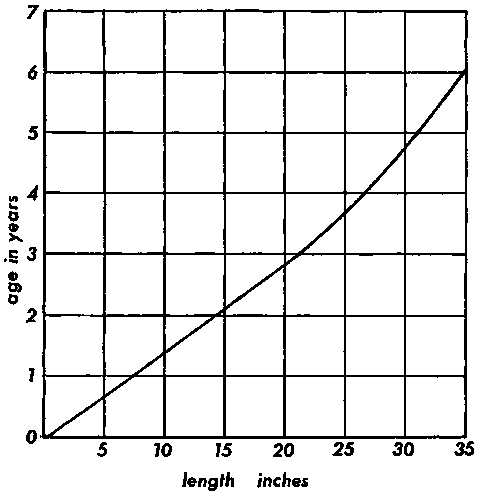
A small percentage of the cod stocks is affected by parasitic worms; the cause of the infestation and means of detecting the presence of worms are described in Advisory Notes 80 and 34 and in a leaflet for trawler crews that is also obtainable from Torry Research Station.
Detailed figures for the quantity and value of cod landed in the UK are given in the Sea Fisheries Statistical Tables and the Scottish Sea Fisheries Statistical Tables published annually by the Ministry of Agriculture, Fisheries and Food and the Scottish Executive respectively.
Nearly 90 per cent of British-caught cod is captured in the trawl, and a further 9 per cent is taken in the Danish seine net; the small remainder is caught mainly by line fishing (1966 figures).
Trap nets and gill nets are used on the Canadian Atlantic coast in addition to trawl and line, and some Scandinavian fishing vessels, notably Icelandic, have considerable success with the purse seine in waters where the net will reach the bottom.
Chemical composition of cod will vary slightly with season, ground and condition of the fish. The following tables are a guide to the average values that can be expected:
|
|
|
water |
protein |
fat |
salt |
ash |
calorific |
|
cod flesh |
avg |
81 |
18 |
0·1 |
0·2 |
1 |
70 |
|
|
avg |
30 |
6 |
64 |
0-4 |
|
515 |
|
cod roe |
|
70 |
24 |
4 |
2 |
|
125 |
|
cod milt |
|
82 |
15 |
1 |
2 |
|
70 |
|
|
minerals mg/100g |
|||
|
calcium |
phosphorous |
iron |
iodine |
|
|
cod flesh |
20 |
200 |
0·6 |
0·5 |
|
cod liver |
30 |
100 |
3·6 |
0·5 |
|
cod roe |
30 |
410 |
1·5 |
0·2 |
|
cod milt. |
40 |
220 |
3·5 |
0·1 |
|
|
A
|
B |
D
|
||||
|
thiamine |
ribo- |
niacin |
panto- |
B12 |
|||
|
cod flesh |
i.u./g |
µg/100g |
µg/100g |
mg/100g |
µg/100g |
µg/100g |
i.u./g |
|
cod liver |
600 |
|
340 |
1·5 |
430 |
11 |
6,000 |
|
cod roe |
|
250 |
550 |
0·8 |
1,965 |
15 |
|
|
cod milt |
|
|
200 |
1·0 |
500 |
5 |
|
The approximate percentage weights of the components of cod, both for ungutted and for gutted fish, are given below. Weights of guts, liver and roe can fluctuate enormously with season, fishing ground and condition of fish. Variation in fillet yield is discussed more fully later.
|
Component |
Percentage |
Percentage |
|
head |
21 |
25 |
|
guts |
7 (range 5-8) |
|
|
liver |
5(range 2-7) |
|
|
roe |
4(range 1-7) |
|
|
backbone etc |
14 |
16 |
|
fins and lugs |
10 |
12 |
|
skin |
3 |
4 |
|
fillet, skinned |
36 |
43 |
|
|
100 % |
100% |
The following two graphs show the weight of a single fillet cut from a fish of given length, and the total weight of fillets that can be cut from a fish of known weight as a result of filleting.
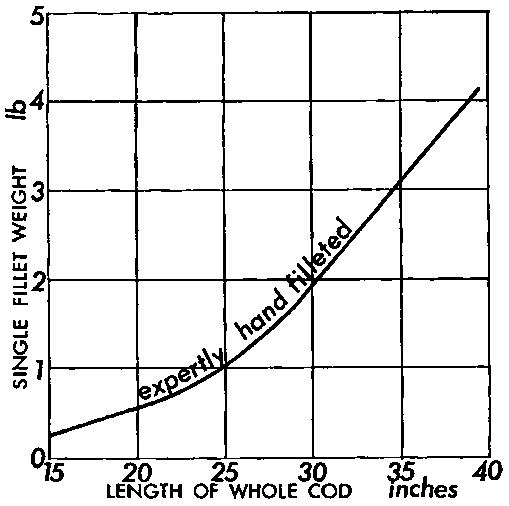
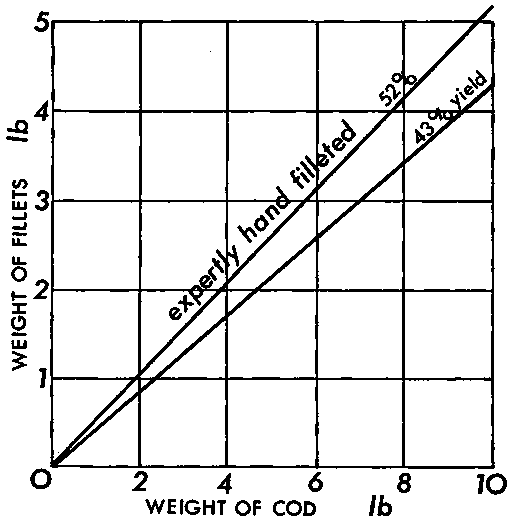
The length of a fillet obtainable from a given length of fish is often of interest to processors; the graph below shows the lengths of fillets that can be cut by machine and by hand.
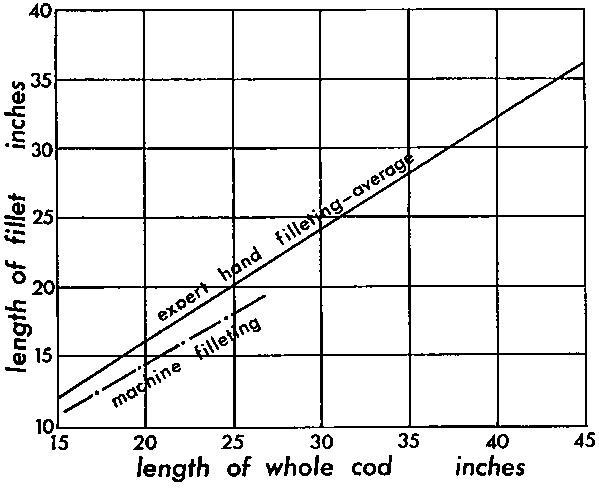
Processing machinery designers, operators and others are often concerned with the breadth of a cod in relation to its length, for example in order to be able to accommodate cod of a certain length between the plates of a quick freezer. The next graph gives the approximate ratio of maximum breadth to length for whole gutted cod.
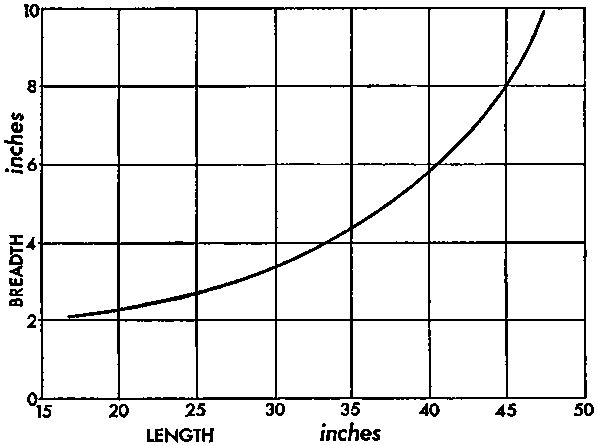
Some physical properties of cod:
|
density: |
chilled cod muscle |
65·8 lb/ft3 at 32°F |
|
|
frozen cod muscle |
61·3 lb/ft3 at 0°F |
|
|
|
60·3 lb/ft3 at -20 °F |
|
specific heat: |
unfrozen 0·8 Btu/lb deg F |
|
|
frozen 0·4 Btu/lb deg F |
|
freezing point: |
the water in cod freezes gradually below about 31°F; at
30°F about a third of the water is frozen, at 28°F about half, and at
23°F about 80 per cent of the water has turned to ice. |
|
thermal conductivity: |
unfrozen cod muscle 3-4 Btu in/ft2 h deg F at
32°F |
|
|
frozen cod muscle 9-12 Btu in/ft2 h deg F at
0°F |
|
|
13 Btu in/ft2 h deg F at -20°F |
|
|
Frozen cod conducts heat about 3½ times better than
unfrozen. |
|
Gutted whole cod: |
stowage rate ft3 |
|
|
without ice |
39/ton fish |
|
|
|
2:1 cod: ice by weight |
{45/ton mixture |
|
|
2: 1 cod: ice and including allowance for fishroom structure;
bulk stowed |
70/ton fish |
|
|
single layers on ice on shelves 9 inches apart; shelf
stowage |
160/ton fish |
|
|
2: 1 cod: ice in boxes including allowance for space taken by
boxes etc. |
96/ton fish |
|
|
frozen in large blocks, including allowance for supporting
structure and access |
60/ton fish |
|
|
(for weight of fish within dimensions of a block, the density
averages about 48 lb/ft3, ranging from 40 for very loosely packed
fish to 55 for a very compact block) |
|
|
|
frozen singly |
75-90/ton fish |
|
cod fillets: |
|
|
|
|
without ice |
37/ton fish |
|
|
boxed with ice for normal inland journey |
75/ton fish |
|
|
frozen in large blocks |
37-40/ton fish |
|
|
frozen in large blocks, with allowance for wrappings, access
etc. |
45-56/ton fish |
|
|
stowage rate |
|
|
Other cod products: |
ft3/ton |
|
|
|
cod livers or roes in bulk |
36 |
|
|
cod liver oil |
39 |
|
|
dried cod in bales |
60 |
|
|
salted cod in bales |
125 |
The main methods of preservation for cod in Britain are chilling in ice, freezing and cold storage, and cold smoking. Cod is the preferred species for fish fingers, and cod enters largely into the manufacture offish cakes. It is normally smoked as skinned fillet, unlike haddock. The main method of processing is filleting, now carried out almost entirely at the ports, and a large percentage of the cod catch is distributed as chilled, frozen or smoked fillets. Small quantities are salted, mainly for export; in some other European countries drying and salting are important methods of preservation.
Storage life of cod products:
|
whole gutted cod in crushed ice |
0-5 days excellent quality |
||
|
at about 32°F: |
6-10 days medium quality |
||
|
|
11-15 days poor quality |
||
|
|
16 days or more - usually inedible |
||
|
|
|
excellent |
remains edible |
|
whole cod or fillets, frozen |
15°F |
1 month |
4 months |
|
quickly soon after capture |
-5°F |
4 months |
15 months |
|
and properly cold stored at: |
-20°F |
8 months |
4 years or more |
|
cold smoked cod fillets |
|
excellent |
remains edible |
|
made from fresh raw mat |
60°F |
2-3 days |
4-6 days |
|
erial and stored at: |
32°F |
4-6 days |
8-10 days |
|
For detailed advice on cold storage see Advisory Note
28. |
|||
|
gutting rate: |
one man can gut about 240 six-pound cod an hour, but the rate
may vary from about 300 an hour for small codling to only 150 an hour for large
cod. |
|
filleting rate: |
one man can fillet about 60-70 six-pound cod an hour or about
90-100 three-pound codling an hour. |
|
season for cod: |
cod can be eaten throughout the year, but eating quality and
yields may be somewhat lower for a month or two after spawning; in Britain cod
are usually poorest in May-July. |
|
freezing rate: |
rates for particular products in particular freezers can be
determined only by experiment, but the following examples will serve as a rough
guide to what can be attained: |
|
thawing rate: |
a single cod about 4 inches thick, taken from cold storage at
-20 °F, will take 8-10 hours to thaw in still air at about 60° F. A
block of whole cod will take about 20 hours under the same conditions but, if
the cod are separated as soon as this can be done without damage, thawing time
can be reduced. |